ksz said:
What follows is just a guess on my part. If you can find an error, jump in and fix it.
Nikon F-Mount = 44mm diameter
Canon EF Mount = 54mm diameter
Full Frame = 36mm x 24mm.
The diagonal of this rectangle measures 43.27mm. Full frame lenses have to produce an image circle with a diameter of 43.27mm. Nikon's F-Mount has a diameter of 44mm, so it's just enough to cover the full frame.
Extended Full Frame = 48mm x 36mm.
This is what is claimed by the professor from Greenland. The diagonal of this rectangle measures 60mm, requiring an image circle with a diameter of also 60mm. Canon's EF Mount has a diameter of only 54mm.
In order for the new body to support both extended full frame and standard EF lenses, it would need a larger mount and an adapter for EF lenses.
I'm also very skeptical about extended full frame. Why introduce yet another format and a new set of lenses, particularly when it's larger and not smaller. Is this a move towards Medium Format?
For the world I couldn't see Canon going with a 4:3 sensor, doesn't make any sense, and there is no way they would change mounts, ... again?
They took some serious heat changing their mount back in 1987 (I think it was 87) and going with a mount almost medium format size. They have gotten past that, and now may have an opportunity to use that extra room. The 54 mm mount has 50% more image area than a 44 mm, the corners of the 24 x 36 sensor don't even come close to the edge of the 54 mm mount, while it is right to the edge on a 44 mm mount, if that is what most others are, I really have no idea or one to measure. I do know Canons id 54 mm though.
You have better image corners with crop cameras because the sensor uses the center of the image circle, so less fall off and straighter light path.
So maybe Canon stays with the 36 x 24 FF, but develops a series of lenses that produce a 54 mm image circle, however you are only using the middle of that for the FF sensor. Acts like a crop camera, but 24 x 36 sensor size, the new lenses would allow a straighter light path and keep the sensor away from the corners, maintains image quality with a high density 22 MP sensor that would be tough to match.
This could be a hard act for Nikon or any other company to follow without changing their mounts, which of course, we know they would never do. : )
Guess we will just have to wait and see.




